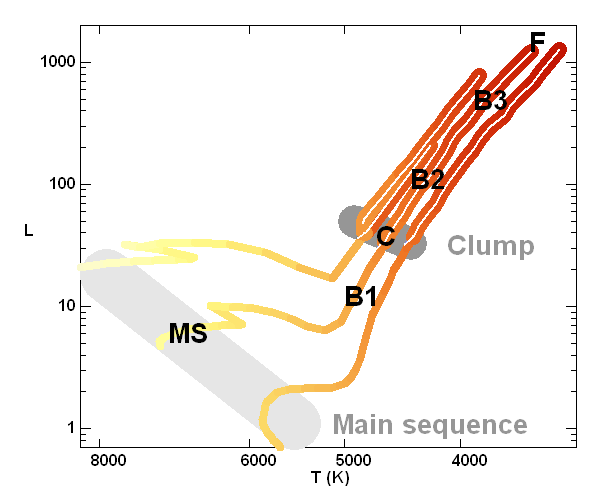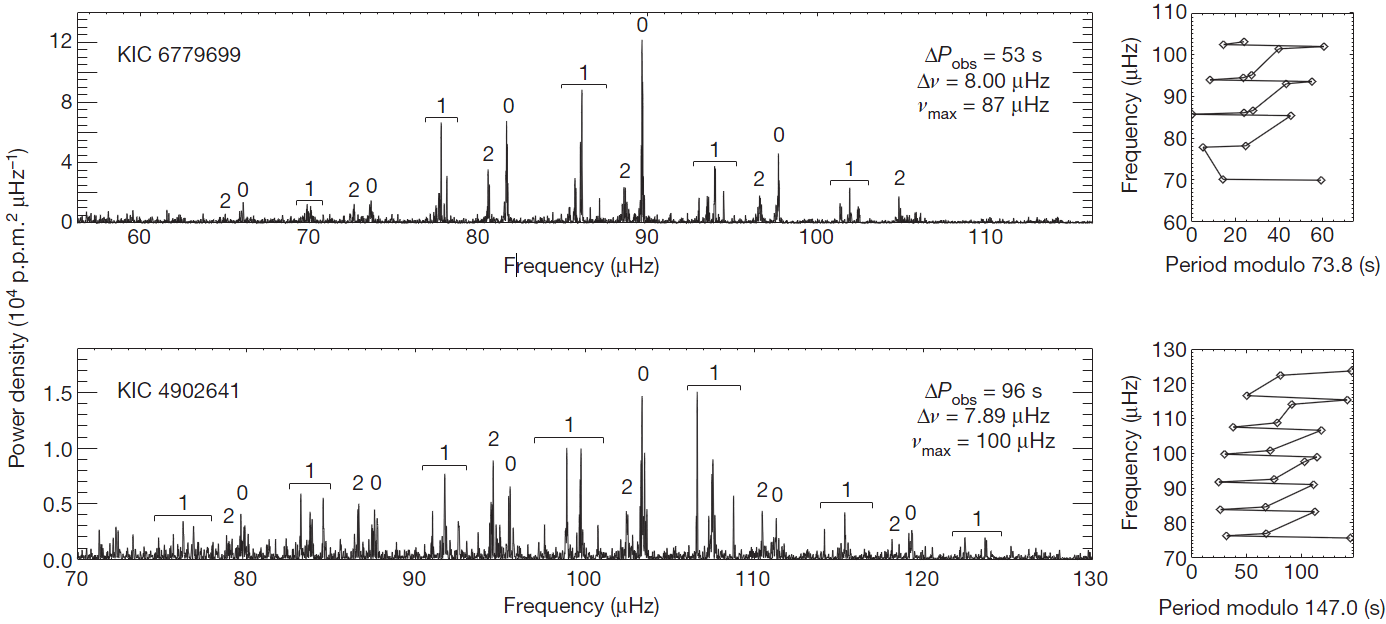An international team has proposed a major breakthrough in the study of stars known as red giants, finding a way to peer deep into their cores to discover which ones are in early infancy, which are fresh-faced teenagers, and which facing their dying days. Red giants are evolved stars that have exhausted the supply of hydrogen in their cores that powers nuclear fusion, and instead burn hydrogen in a surrounding shell. Towards the end of their lives, red giants begin burning the helium in their cores."
The Kepler and CoRoT space telescope allow asteroseismogists to continuously study star light from hundreds of red giants at an unprecedented level of precision for nearly a year, giving a window into the stars’ cores. The changes in brightness monitored at a star’s surface are a result of turbulent motions inside that create sound waves. These waves travel down through the interior and back to the surface, and allow us to analyze the stellar interior.

In the classical Herzsprung-Russell diagram, there is no way to distinguish a ’young’ red giant that burns hydrogen in shell from an oldest one that burns helium in its core. Both evolutionary states present very similar luminosity and effective temperature, despite the fact that their core structures are very different (Fig 1). With the help of asteroseismogy, namely the measurement of mixed modes caused by the coupling of pressure waves in the convective envelope and gravity waves in the core, it becomes possible to disentangle the evolution signature.

The discovery of the mixed modes were jointly achieved by 2 teams, one at the Observatory of Paris, with the Kepler and CoRoT observations. These modes result from the coupling of gravity modes trapped in the core with pressure mode visible at the star surface. The absence of efficient coupling makes the detection of the solar gravity modes very difficult. Mixed modes concerns dipolar modes : instead of one single pressure mode, one observes a forest of thin peaks (Fig 2). These peaks present an almost regular spacing in period. This period depends on the core size and structure, hence on the evolutionary status. Measuring it allows us to determine the stellar age (Fig 3).

Launched in December 2006 in a low-Earth orbit, the French-led satellite CoRoT has discovered many exoplanets, and provided many breakthroughs is asteroseismology. http://smsc.cnes.fr/COROT/index.htm
Launched in March 2009 in an orbit around the Sun, Kepler is monitoring more than 156,000 stars in the constellations of Cygnus and Lyrae. Previous studies of red giants using ground-based telescopes were limited by disturbances in the atmosphere and interruptions due to daylight. Kepler mission of NASA
References
P.G.Beck,T.R.Bedding, B.Mosser, R.A.Garcia, T.Kallinger, S.Hekker, Y.Elsworth, S.Frandsen, D.Stello, F.Carrier, J.De Ridder, C.Aerts, T.R. White, D. Huber, M.-A.Dupret, J.Montalban, A.Miglio, A.Noels, W.J. Chaplin, H.Kjeldsen, J.Christensen-Dalsgaard, R.Gilliland, S.D.Kawaler. Detection of gravity-mode period spacings in red giant stars by the Kepler Mission Science, March 17, 2011
T.R. Bedding, B. Mosser, D. Huber, J. Montalban, P. Beck, J. Christensen-Dalsgaard, Y.P. Elsworth, Rafael A. Garcia, A. Miglio, D. Stello, T.R. White, J. De Ridder, S. Hekker, C. Aerts, C. Barban, K. Belkacem, A.M. Broomhall, T.M. Brown, D.L. Buzasi, F. Carrier, W.J. Chaplin, M.P. Di Mauro, M.A. Dupret, S. Frandsen, R.L. Gilliland, M.J. Goupil, J.M. Jenkins, T. Kallinger, S. Kawaler, H. Kjeldsen, S. Mathur, A. Noels, V. Silva Aguirre & P. Ventura. Gravity modes as a way to distinguish between hydrogen- and helium-burning red giant stars Nature, March 31, 2011
